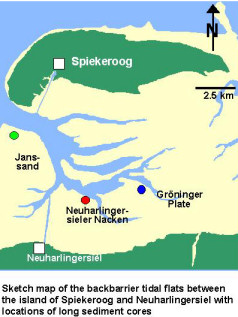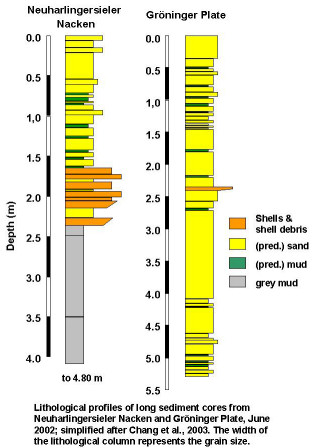
BioGeoChemistry of Tidal Flats
Long sediment cores provide an insight into the shallow subsurface bio- and geosphere
The Wadden Sea is a highly dynamic intertidal system and plays an important role in transport, recycling, degradation, and accumulation of organic matter of different origin. Within the marine environment, the coastal sediments receive the highest amounts of organic material and exhibit the highest biogeochemical activities. Different microbial remineralisation processes occur within the sediments in a vertical sequence that follows the decreasing redox potentials of the respective electron acceptors: oxygen, nitrate, manganese and iron(oxy)hydroxides, sulfate, and carbon dioxide.
 Most studies of Wadden Sea sediments are restricted to near-surface sediments. Very little information is presently available about deeper sediment layers. Sediment cores up to a depth of 5.5 m from different locations in the backbarrier tidal flats between the island of Spiekeroog and Neuharlingersiel provide an insight into this largely unknown shallow subsurface bio- and geosphere. At Neuharlingersieler Nacken and Gröninger Plate, cores were taken at nearly the same locations in June 2002, October 2003, and February 2004. A detailed lithological and stratigraphical interpretation of the cores from June 2002 is given by Chang et al. (2003).
Most studies of Wadden Sea sediments are restricted to near-surface sediments. Very little information is presently available about deeper sediment layers. Sediment cores up to a depth of 5.5 m from different locations in the backbarrier tidal flats between the island of Spiekeroog and Neuharlingersiel provide an insight into this largely unknown shallow subsurface bio- and geosphere. At Neuharlingersieler Nacken and Gröninger Plate, cores were taken at nearly the same locations in June 2002, October 2003, and February 2004. A detailed lithological and stratigraphical interpretation of the cores from June 2002 is given by Chang et al. (2003).
A sediment core taken at the Neuharlingersieler Nacken in June 2002 was investigated in detail regarding the geochemical composition of the organic matter, the composition of the microbial communities, the bacterial activities, and the pore water chemistry. In this core, sediments below 2.4 m depth consist of grey mud (more than 75 % clay and silt) assigned to salt marsh and upper mud flat environments (Chang et al., 2003). They are overlain by an interval with abundant shell layers with an erosive base. The upper 1.8 m comprise mainly fine-grained sand with mud admixtures and thin mud intercalations interpreted as deposits of mixed and sand flat environments.
Sediments of the Gröninger Plate cores (depth up to 5.5 m) are dominated by sand with few mud- or shell-rich intercalations. They are interpreted as an alternation of tide-dominated and wave-dominated facies deposited in a sand-flat environment (Chang et al., 2003).

| <<back | All publications |